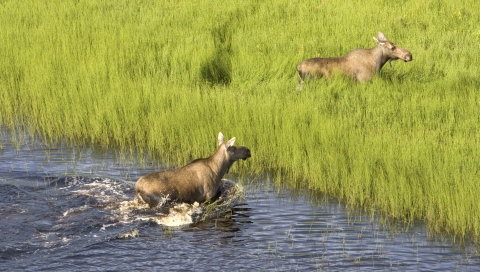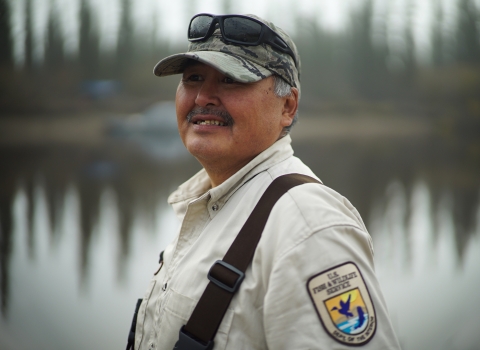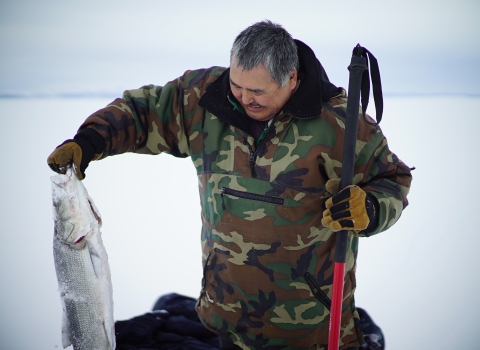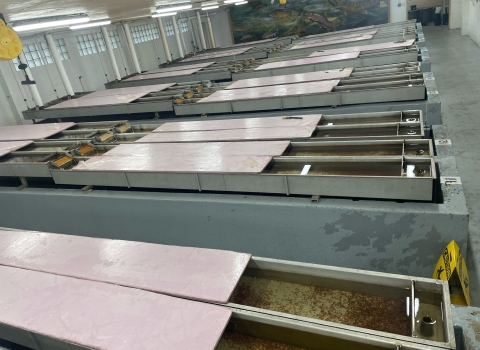Why are two and a half million acres of land in Northwest Alaska conserved as a wildlife refuge? What makes this place so special? In a word, wetlands. The lands that today make up Selawik National Wildlife Refuge, and that are the homeland of generations of Iñupiat, are top-notch wildlife habitat consisting largely of wetlands.
In you fly over the refuge, you won’t see any boundary fences or roads. You’ll see a maze of interconnecting waterways, tundra lakes, and ponds, tendrils of boreal forest reaching out from the interior, and two river deltas. For much of the year, you’ll see an expanse of white, as this Arctic area is covered in frozen snow drifts; but in the summer multiple hues of green abound.
During those endless summer days, thousands of waterfowl, shorebirds, fish, insects, and other creatures rest, breed, and feed in the vast wetlands complex that is the heart of Selawik Refuge. These include Canada geese, black scoters, whimbrels, sandpipers, Northern Pike, and multiple types of whitefish. In winter months, caribou from the Western Arctic Herd, Alaska’s largest, make their way here to forage for lichens and other plants that thrive in wet and spongy habitats.
Wetlands are such a predominant feature of Selawik National Wildlife Refuge that when the U.S. Fish and Wildlife Service recently undertook a National Wetlands Inventory, the refuge was one of the priority sites selected. In 2016 a USFWS field crew visited over 290 locations on the refuge via helicopter to make sure remote sensing datasets lined up with reality on the ground. In the end, the joint assessment for the Wetlands Inventory and National Hydrography Dataset identified over 16,000 wetland sites within the refuge.
Wetlands support wildlife and also support a way of life. Today, two communities of mainly Iñupiaq residents live within the boundaries of the refuge, with several more nearby. Local people rely on foods from the surrounding lands and waters, including the mighty sheefish. In fact, the name of the refuge and the larger community, Selawik, derives from this impressive whitefish: Selawik = Siiḷvik = place of sheefish (sii). Sheefish not only spawn in the upper Selawik River, but spend most of their time in the river delta and surrounding estuaries.
The Selawik River delta in particular is a place of fishy abundance. Whitefish research done in the lower Selawik by U.S. Fish and Wildlife Service scholar Randy Brown showed that these rich wetlands are crucial rearing areas not just for young humpback and broad whitefish from the Selawik River but for young fish from the nearby Kobuk River system as well. The abundance of these whitefish, and their relatives the least cisco, means fish-eating fish (pike and sheefish) flourish here as a result.
Despite the richness and bounty of these lands, there are threats. As temperatures warm and the period between spring breakup and winter freeze-up lengthens, permafrost is changing. The underlayer of permafrost is the reason there is so much surface water — and therefore so many wetlands — within Selawik Refuge. This year-round frozen soil prevents water from draining through, holding it instead in lakes, ponds, and sloughs. Permafrost makes it possible for wetlands to persist here even without a large input of water: Selawik receives just over 15 inches of precipitation per year on average, well below the US average of about 38 inches.
As global temperatures rise, the permafrost is less substantial. The “active layer,” meaning the top section of ground that thaws each summer, is getting deeper. Tundra lakes and ponds, which are held in by permafrost below them as well as on the edges, are changing. Inland areas in the region are experiencing lake loss, or drying, while river deltas are seeing lake expansion. Remote sensing revealed that between 1999–2014 the Selawik-Kobuk region had a roughly 3% loss of lake area, with 394 out of 2771 lakes experiencing drainage (Nitze et al 2017).
Changes in lakes mean changes for wildlife. In the 1990s, Selawik Refuge was a frequently used field site for goose banding projects, but due to both a decline in the flock sizes of white-fronted geese and a drying of lakes, sampling efforts have shifted toward the Noatak and Seward Peninsula. This is but one example of how changes in wetlands may spell changes for the environment, wildlife, and human uses of the Selawik Refuge in years to come.
Citation: Nitze I, Grosse G, Jones BM, Arp CD, Ulrich M, Fedorov A, Veremeeva A. Landsat-Based Trend Analysis of Lake Dynamics across Northern Permafrost Regions. Remote Sensing. 2017; 9(7):640. https://doi.org/10.3390/rs9070640
In Alaska we are shared stewards of world renowned natural resources and our nation’s last true wild places. Our hope is that each generation has the opportunity to live with, live from, discover and enjoy the wildness of this awe-inspiring land and the people who love and depend on it.








